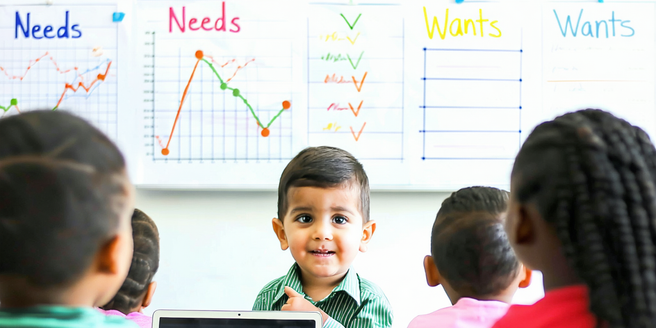
Understanding Financial Concepts for Kids
| Concept | Age Group | Example |
| Counting Money | Preschool | Counting coins |
| Needs vs Wants | Elementary | Choosing a toy or food |
| Saving | Middle School | Allowance portioning |
| Budgeting | Middle School | Making a simple budget |
| Banking Basics | High School | Understanding bank statements |
| Investing | Teenage | Simple stock market game |
The Importance of Early Financial Education
Instilling financial literacy from a young age is crucial in paving the way for a secure financial future. Children who receive an early education in managing money are more likely to develop strong financial habits as adults. Starting early empowers kids to understand the value of money through simple concepts and real-life applications. Studies have shown that children who learn about finances early tend to make better financial decisions, save more, and are less likely to fall into debt. By incorporating financial lessons into a child’s daily routine, they become accustomed to the idea that managing finances is a regular, integral part of life, and not just something to worry about in adulthood. This proactive approach encourages independence and responsible decision-making, fostering a generation of financially savvy individuals.
Interactive Ways to Teach Saving and Spending
Gamifying the concept of saving and spending is one of the most effective ways to engage children in financial education. From setting up a mock store using play money to utilizing apps designed for kids to learn about financial transactions, interactive activities make the process enjoyable. Parents can introduce children to the idea of savings goals by creating a visual chart where kids can track their progress towards buying something they want. A family savings challenge, where everyone works together towards a common financial goal, can also be an excellent bonding experience. Additionally, role-playing scenarios where children decide how to allocate their funds gives them practical experience in managing money. These interactive methods help reinforce the knowledge that money is a finite resource that should be used wisely.
Creating a Kid-Friendly Budget Plan
Creating a budget plan that is comprehensible for children is an invaluable tool for teaching money management. Start by explaining income and expenses in simple terms they can relate to, such as their allowance or money gifts they receive. Help them list their needs and wants, teaching them how to prioritize spending. Introduce them to the concept of saving a portion of their money regularly and set a realistic goal for them to reach. Visual aids, such as colorful charts or apps that track their expenses and savings, can make budgeting more relatable. Allow them to take part in family budgeting activities, such as planning a grocery shopping trip or saving for a family outing to see firsthand how budgeting works in the real world. This approach makes financial planning a routine and approachable practice for kids.
Games and Activities for Money Management
Engaging children in games and activities can be a fun and practical way to teach money management skills. Board games like Monopoly or The Game of Life offer lessons on budgeting and financial decision-making. Crafting a “store” environment where children can use play money to buy and sell small household items can be an enriching experience in understanding transactions. Apps designed with interactive finance simulations for children are also beneficial, providing digital platforms where they can practice saving, spending, and budgeting in a virtual setting. Additionally, organizing a pretend ‘bank’ at home where they can deposit their savings can reinforce banking concepts and currency management. These playful interactions foster a hands-on learning approach, vital for building solid money management skills at a young age.
Teaching the Value of Earning and Charitable Giving
Teaching children about earning and the value of money often starts with household chores or small tasks they can complete in exchange for a reward. It’s essential to instill the understanding that money is earned through effort and work. Introducing them to the satisfaction of earning income can positively affect their work ethic and appreciation for what they possess. Pair this lesson with the importance of charitable giving, using a portion of their earnings or savings. Encouraging them to donate toys or part of their allowance to charity teaches empathy and responsibility, showcasing money as a tool for positive social impact. Highlighting stories of individuals and organizations who make significant differences in their communities through philanthropy can further inspire them to value both earning and giving.
Incorporating Financial Lessons into Daily Life
Financial education doesn’t have to be a separate lesson plan; it can be woven into daily routines seamlessly. Grocery shopping, for instance, provides a perfect opportunity for children to learn about comparing prices and understanding discounts. Encouraging them to participate in paying bills can introduce them to regular expenses and the concept of financial obligations. Setting family savings goals for a future vacation or a large purchase teaches the collective effort of financial planning and saving. Discussing daily choices that involve money, such as preparing meals instead of dining out, helps them see the real-life application of cost-saving measures. By integrating financial lessons into everyday activities, children receive a continuous, practical education that isn’t confined to a specific time or place.
Effective Tools for Financial Literacy in Schools
Schools play a pivotal role in financial literacy education by utilizing effective tools and resources. Incorporating financial education into the curriculum through dedicated courses ensures that all students receive essential money management skills. Access to interactive software and digital platforms related to financial topics can enhance classroom learning and engagement. Workshops, guest speakers from financial institutions, and practical activities like ‘mini-economies’ allow students to apply financial principles in realistic scenarios. Collaborations with parents and communities in school projects and fairs can further cement these lessons. Providing teachers with comprehensive training in financial topics equips them to deliver these programs effectively. As these tools are implemented, schools significantly contribute to building a future generation capable of making informed financial decisions.
Role of Parents in Children’s Financial Learning
Parents are often children’s first and most influential teachers regarding financial learning. By fostering an open dialogue about money, parents can demystify financial concepts and encourage healthy attitudes towards saving, spending, and investing. Simple practices, such as paying kids a small allowance in exchange for chores and tasks, provide a foundation for financial responsibility. Regular conversations about their own money-management experiences and decisions offer children real-world insights into managing finances. Parents can also guide their children in setting personal savings goals, thereby teaching them planning and patience. By modeling responsible financial behavior, parents instill lasting values and practices that children are likely to adopt in adulthood. These shared experiences underscore the importance of parental involvement in developing financially literate and mindful children.
Long-Term Benefits of Financial Mindfulness for Kids
Promoting financial mindfulness among children offers numerous long-term benefits that extend into adulthood. Early financial education can lead to a more profound sense of resourcefulness, enabling children to make informed and confident financial decisions later in life. Understanding financial principles from a young age contributes to improved budgeting skills and an increased ability to build and sustain savings. This education often results in fewer instances of debt and better credit management as they grow older. Financially mindful individuals are more likely to achieve their personal and professional goals, such as purchasing homes or starting businesses. Additionally, these skills foster a mind that values saving for emergencies and retirement, ensuring financial stability and peace of mind. Ultimately, instilling financial mindfulness transforms children into adults who contribute positively to society’s economic health.

